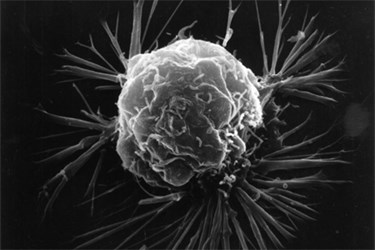New Synthetic Molecule Causes Cancer Cells To Self-Destruct
By Chuck Seegert, Ph.D.

An international team led by University of Texas researchers has shown for the first time that ion transport can induce cancer cell self-destruction.
Nearly 20 years ago a natural molecule was discovered to have an anticancer effect due to its ability to transport ions across cell membranes. This molecule, called prodigiosin, inspired the development of synthetic molecules that act similarly.
Maintaining the proper electrolyte balance, or concentration of ions inside the cell wall, is a significant requirement to keep a cell alive. If this balance is lost and concentrations become too great, the cells will undergo apoptosis — a phenomenon that causes a cell to disassemble in what is known as programmed cell death.
This is a normal function in many cells that occurs when they age. Some cancerous cells, however, lose the ability to undergo apoptosis and accumulate into tumors. It is thought that they do this through an ability to control their electrolyte balance, thereby preventing the cell death.
While the use of synthetic ion transporters has been attempted before, the new research study published in Nature Chemistry is unique, because it demonstrates for the first time that there is indeed a relationship between ions being transported into the cell and the cell’s subsequent self-destruction.
"We have thus closed the loop and shown that this mechanism of chloride influx into the cell by a synthetic transporter does indeed trigger apoptosis," said Jonathon Sessler, professor at the University of Texas at Austin's College of Natural Sciences and co-author of the study, in a recent press release. "This is exciting because it points the way towards a new approach to anticancer drug development."
The synthetic transporter created by the University of Texas team works by binding chloride ions and enclosing them inside an organic envelope. This envelope allows the ion to dissolve into the cell membrane, which is mostly lipid and fats organized into a bilayer. Their research also showed that the transporter tends to use sodium channels that are part of cell’s membrane, which leads to sodium being transported in as well. Eventually, the cell’s electrolyte balance is deranged enough that apoptosis is triggered, leading to self-destruction.
Initially, the effectiveness of the ion transporters was tested in a model system that used synthetic lipid membranes. Positive results from the model system allowed the team to graduate into a culture system composed of human cancer cells. There, they were able to show that the ion balance of the cells was changed and that the imbalance caused the cells to self-destruct — a finding that had never been observed before.
Though the new ion transporters were tested in a cancer cell culture and shown to be effective, they are not yet specific for cancer cells. The research team continues to work to find ways to selectively bind these transporters to cancer cells exclusively.
Cancer self-destruction using the apoptotic pathway is an area of ongoing research. In addition to ion transport, nanoparticles have been used to target cancer cells and remotely induce cell death.
